But maybe the fact that wrestling is fake is precisely what draws me to it. I get no pleasure out of legitimate fights in which people pummel each other into early-onset Alzheimer’s, but I’m very taken with one of the earliest sentences in Bret Hart’s memoir Hitman, where he writes “To me there is something beautiful about a brotherhood of big, tough men who only pretend to hurt one another for a living instead of actually doing it.” That says it all to me: I am thrilled by the notion of highly trained athletes putting on a show that stresses entertainment, putting their bodies on the line while doing their best not to harm the other guy. There’s something kind of poetic in that, and I’ve quickly come to believe that the best wrestling is poetry, capable of silent storytelling with the in-ring continuity of storyline rivalries, injuries both real and faked, and a mixture of careful spot planning and split-second improvisation.
Speaking of Hart, he became my immediate favorite as I began trawling through classics on the WWE Network. His promos were stiff, but his in-ring work spoke more than he ever could on a mic, and no matter who I saw him paired with, he always adapted to their style and made them look as good as they ever did by selling each blow with finesse and showcasing an elaborate series of submission holds, counters and grapples that are a far cry from the finisher-heavy setup of the modern WWE matches I’ve seen. I love how many of his matches were decided by flash moments of quick thinking, like the kick-off from the corner into a roll-up pin that ends his Survivor Series bout with Steve Austin, or the back-and-forth holds in his Wrestlemania X match with brother Owen. I’ve had to venture into Japanese wrestling to see the same kind of ring intelligence today that Hart showed regularly.
Running through a swift redux of the various eras of WWE, I got a more complete picture of the ebb and flow of the company’s push-pull between giants and smaller, savvier technicians; how great commentary can turn a simple fight into a contest of immortals (will WWE ever find another JR?); how the Attitude Era is both much worse and as good as its legend. I ran through the highlights of Daniel Bryan’s hard-won fight to Wrestlemania XXX and marveled at how many great matches Undertaker put on at the big show year after year, especially those justifiably legendary Shawn Michaels bouts. I even dug into the company’s amusingly arrogant documentaries on the ratings war with WCW, a series of self-fellating tributes to Vince McMahon’s genius that nonetheless offered a decent primer on how wrestling went from the edge of obsolescence to its greatest pop cultural heyday.
When I moved into this year’s programming, however, I realized it was a bad year to leap into WWE. Injuries sidelined many of the best wrestlers (a running theme even in other promotions), and months without Daniel Bryan, Seth Rollins and Sami Zayn showed how poorly the creative team had built the rest of the roster as a fallback. Though the company has one of the strongest rosters ever, and technical ability has never been more readily on display, the company’s main programs were typically abysmal, filled with plotlines that grew stale even for this total neophyte and matches that failed to capitalize on the performers’ abilities and instead featured sloppy brawls and repetitive pairings. Worst of all was the total flop of the “Divas Revolution,” in which an extremely talented roster of female wrestlers got reduced to amateurish match plotting, directionless narratives and an over-reliance on teams to ensure the maximum amount of t&a was on-screen.
But if WWE’s main program was a shitshow, the explosion of talent on their developmental NXT show made this a great year to try out wrestling. NXT did everything Raw didn’t: it told simple, coherent stories that both new and long-time fans could follow and appreciate, and it foregrounded the wrestling itself with performers who had exceptional ring skills. It’s almost laughable to even think of this show as WWE’s testing ground, as the talent on display and the freedom afforded to that talent made even the average weekly filler better than all but the most focused Raw episodes. Picking out favorite wrestlers was impossible. The Vaudevillains tag team were a hilarious, instantly lovable gimmick; Tyler Breeze took the most obnoxiously “topical” character since World’s Strongest Vegan Daniel Bryan and did as much with it as Bryan did his role; Apollo Crews was like a Goldberg who could actually wrestle, maybe incapable of performing a long-term match but so nimble and risky that you can’t help but pop when he comes out; and Samoa Joe looked so strong and on-form that I couldn’t believe he’d been around for forever.
And that’s not taking into account the greatest aspect of all, how their women’s division did everything right that the Divas roster did wrong, spotlighting the fact that women could be as good in the ring as men. It’s been a shame to see the matches here compared to the way that people like Paige, Charlotte and Sasha Banks have fared on the main roster, and one can only hope that NXT’s rapturous 2015 reception might trigger at least some changes on Raw, which frankly has to do something to stanch the bleeding of its dwindling viewership.
But NXT wasn’t the only pleasure to be had. I dipped a toe into NJPW and loved what I saw, wrestling built less on big spots than methodical grapples, stiff blows and ring psychology, so good that I didn’t need to speak Japanese to follow every detail. It’s everything I love about wrestling, and if this was apparently a tepid year for the promotion, then I can’t wait to explore it further and see how good it is when firing on all cylinders. I was also surprised to discover that WWE mounted one great long-form narrative around the unlikeliest of stories: the Fall and Rise of Roman Reigns. Reigns became one of the most hated men in the company at the top of the year when WWE boosted him over Daniel Bryan in two straight PPVs, only for creative to ingeniously win over fans by screwing Reigns for the better part of a year, making his snap at the recent TLC event and subsequent title win the next night feel hard-won rather than gifted on a silver platter. It was a demonstration of how great the company can be when it bothers to pay attention, and I hope the momentum carries into 2016.
It’s hard to talk about wrestling in broad strokes without a focus on the individual matches that best exemplify it, so perhaps I can better explain what made me an instant fan by talking about my favorite matches of the year. With the caveat that I’ve had little exposure to smaller and independent promotions, my top 10 is as follows:
10. Bayley vs. Sasha Banks (NXT Takeover: Respect)30-Minute Iron Man Match for the NXT Women’s Championship, October 7, 2015
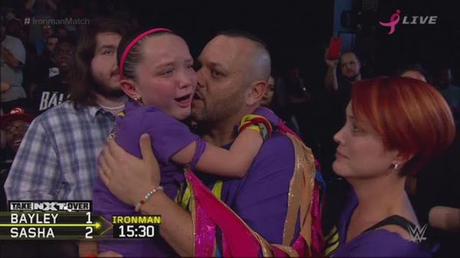
I have to say I’m not much of a fan of the Iron Man format. Plenty of one-fall bouts can go a half-hour to 45 minutes and maintain a sense of suspense and drama that the telegraphed, timed back-and-forth of an Iron Man negates. (To be honest, I’m not even as wild about the Bret Hart and Shawn Michaels Iron Man as I am for their other pairings, though each performer’s technical fundamentals makes it the best sold and best told of these gimmicks I’ve seen). But for two women to main event a special and to do so with a format built around the need for endurance and adaptability is such a major event for WWE, not to mention the special chemistry Bayley and Banks have. Everyone will remember Banks going full heel by smashing Bayley onto the screen then taunting Bayley’s biggest kid fan, Izzy, by straight up stealing her headband and prancing around as a laid-out champ was counted out. But it’s no less compelling that good-natured hugger Bayley herself snapped and applied some devious moves, viciously attacking Sasha’s hand to negate her opponent’s crossface wristlock in an echo of Sasha’s moves at Takeover: Brooklyn. The finale was a bit too obvious, but the effort throughout, building from their feud without simply duplicating prior highlights. But it was when the match had ended and the roster filed out to pay their respects to this historic moment, with not only the two competitors but even vets like William Regal openly shedding tears for what it all meant, that this became truly transcendent.
9. HARASHIMA & Ken Ohka vs. Hiroshi Tanahashi & Yohei Komatsu (DDT Muscle Mates)Inter-promotional Tag Team Match, November 17, 2015
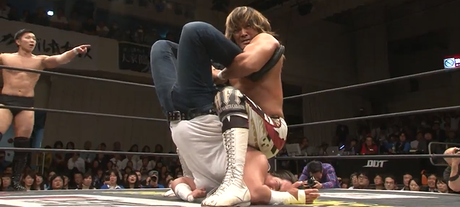
I love Hiroshi Tanahashi. Even a barely exposed mark like me can tell he isn’t the best wrestler in NJPW, and both heir apparent Kazuchika Okada and Coolest Man Alive Shinsuke Nakamura have better ring adaptability and bigger move-sets. But if Tanahashi is the Cena of Japan, he’s also far more versatile in both his moves and his image, a top face who is more than willing to play the heel depending on what he reads from a crowd. He goes full heel in NJPW’s crossover event with independent promotion DDT, having set things in motion by complaining in a preceding press conference of having to take time out of being the biggest star in Japan to help out some rinky-dink indie outfit. So when he shows up for this match, he’s greeted with boos so loud it’s hard to believe they can come from so modest a crowd, and every single time DDT’s HARASHIMA and Ken Ohka gets a hit on either Tanahashi or NJPW scrub Yohei Komatsu, the pops are deafening.
Tag matches are all formulaic, but this one benefits from a lack of complicating factors; Tanahashi does his best work at ringside, letting Komatsu deal with whomever is tagged in while taking the other person out into the crowd for an up close and personal brawl. But even this keeps things simple, pitting nasty big-timers against underdogs small fries who withstand the beatings and make well-timed attacks on revealed weaknesses. One thing I like about Japanese style wrestling is how much everyone trusts an audience to be as wowed by well-executed, passionately delivered basic attacks as they would be by big spots, and it’s great to see forearms and slaps get such big reactions thanks to good storytelling behind it. I’m also exceptionally fond of the literal, honest-to-God Power Point presentation that Tanahashi gives after the match in which he manages to go step by step through his love of wrestling and manage to get the crowd on his side while talking all about himself by conveying his deep respect for the sport and thus for DDT and his competitors. It’s both a dorky showing even by the standards of the air guitar-wielding icon and a sweet, shoot acknowledgment of the respect and passion that unites wrestlers regardless of their exposure and fame.
8. Roderick Strong vs. Zack Sabre, Jr. (PWG Don’t Sweat the Technique)Singles Match for the PWG Championship, April 3, 2015
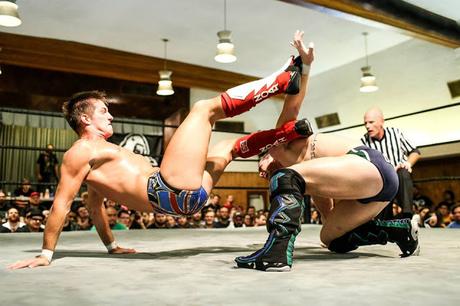
Someone recommended this to me since I expressed an interest in technical wrestling and I was utterly blown away. Strong makes an immediate impression as a solid wrestler with great ring awareness, but Sabre just embarrasses him at times with a textbook command of holds and counters that he wields with fluid grace, forever slipping out of Strong’s rougher attacks and locking up arm into grips that sent limbs at perilously stretched angles. This is wrestling at its purest, so focused on technique that even when the action spills onto the apron or the floor, it immediately gets back in the ring. God bless the exceptionally strong commentary for naming even the moves executed for a split second, as well as for sudden digressions into elaborate poetry, such as an extended comparison of limb targeting to bank deposits, resulting in the greatest ringside line I heard this year: “As the great economist Adam Smith said, ‘There is no greater force in the universe than compound interest,’ and Zack Sabre Jr. is making some wise investments in the early moments of this match.” I loved the back-and-forth of the match, how Sabre’s effortless escapes and reversals got Strong more and more pissed, until he finally snaps and just starts stomping the poor kid’s face. It’s such a simple end compared to how all the other matches on this list end, but it felt just as powerful as a WWE PPV closer for how precisely it tied up a nifty bit of psychology. Sabre is heavily tipped to join NXT next year; on this strength of this match alone, it’s maybe the wrestling event I most want to see in 2016.
7. Hiroshi Tanahashi vs. Shinsuke Nakamura (G1 Climax)G1 Climax Final, August 16, 2015
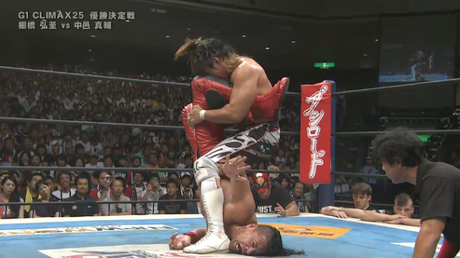
I didn’t quite know what to make of this match at first, because it was the first Japanese match I watched. The slow pace was confusing to someone who was still watching American PPV classics as an introduction and thus thought of great matches as blow-outs, but as I got more into methodical wrestling, I came to see why everyone’s favorite wrestling geek, Dave Meltzer, gave it five stars. The steady build shows smart psychology from both men, with Tanahashi targeting Nakamura’s legitimate elbow injury as well as going after the leg his opponent uses for his running knee Boma Ye finisher, while Nakamura works over Tanahashi’s arm to set up his armbar submission. The careful establishment of these attacks may not be much to see at first, but it pays off when the opponents suddenly, exhilaratingly kick into high gear, so that when Nakamura rolls out of the way of Tanahashi’s High Fly Flow splash and pops up into a Boma Ye, he executes it at half-strength and immediately lays out in agony as he grips his weakened leg, in too much pain to go for a pin.
One thing I’ve heard about Japanese wrestling (and very much like) is that finishers are still treated as such, meaning that it means something for someone to actually withstand one and come back for more. Thus, when both fighters rally their strength and start launching power moves at one another, you can feel the crowd go electric when each wrestler manages to get out of a pin or a hold because this doesn’t happen four times a week like it does on Raw. So when Tanahashi hits a High Fly Flow and then goes up and hits another before the pin, the crowd reaction when Nakamura kicks out at two-and-three-quarters is monumental and venue-trembling, equal to the crazed reactions of Taker/Michaels at Wrestlemania 25. Some have complained that Tanahashi wins and thus gets to main event his umpteenth Wrestle Kingdom while Nakamura settles for second best (or third, given the likelihood of Tanahashi passing the torch to Kazuchika Okada on January 4. But no one who takes the punishment he does here walks out a loser, and the finale of the two men battling it out on the top turnbuckle as Nakamura can only delay the inevitable splashes coming his way is as good as wrestling gets.
6. Jay Lethal vs. A.J. Styles (ROH Final Battle)ROH World Championship Match, December 18, 2015
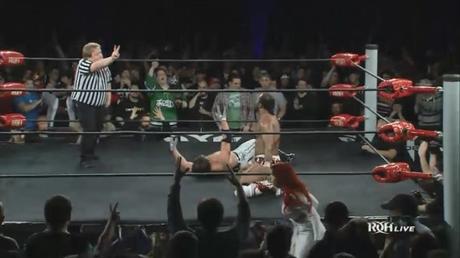
A.J. Styles has had an up and down two years, hitting NJPW like a bomb in 2014 and immediately tossing out MOTY contenders, but also breaking two wrestlers’ necks with his Styles Clash finisher before closing out 2015 with a back injury of his own that has fans nervous about his future. Yet he wrestled his best match of the year on that injury, against Ring of Honor champ Lethal at the promotion’s marquee event. Lethal naturally targets A.J.’s back to build heat, and even simple bear hug grapples can make you wince when you wonder about the real impact. But Styles gives as good as he gets, and the two put on an epic show that mixes mat-clinic reversals with free-form big spots. A sequence where each wrestler performs a series of reversals into sick powerbombs, neckbreakers and suplexes is an early highlight, while things get manic around the time Lethal lands two suicide dives, sends Styles into the crowd, only to go for a third in time for Styles to come to and springboard from a barricade to meet a diving Lethal with an elbow to the face. Add a table crash so harrowing that the fact it’s almost entirely off-camera detracts nothing from its power for good measure, and you’ve got an instant classic.
5. (TIE) Brock Lesnar vs. John Cena vs. Seth Rollins (Royal Rumble)Triple Threat Match for the WWE World Heavyweight Championship, January 25, 2015
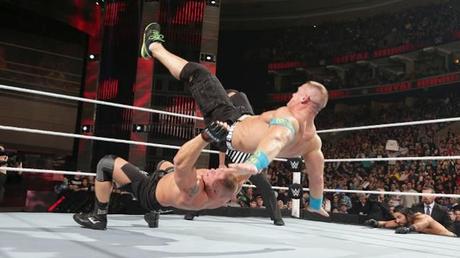
Brock Lesnar vs. Roman Reigns [vs. Seth Rollins] (Wrestlemania 31) WWE World Heavyweight Championship Match, March 29, 2015
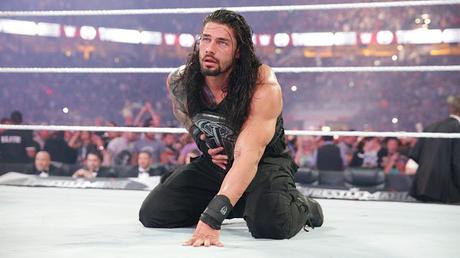
These are two matches with two entirely different narrative aims that are linked by a core notion: the terrifying indestructibility of Brock Lesnar. For someone who originally left WWE in the most ignominious fashion, leaving a farce of a farewell match to a chorus of boos, Lesnar has received such massive reactions since his return it’s hard to imagine he ever left at all, and he had an incredible year in 2015. After the sluggish, concussed match that ended Undertaker’s Streak, Lesnar and Taker rebounded with two solid, strong showings at Summerslam and Hell in a Cell, but it was these two early matches that really set the standard for the Beast Incarnate.
Both the Royal Rumble Triple Threat and the Wrestlemania singles bout are examples of WWE taking its weaknesses with patient building and finisher over-reliance and turned them into comic masterpieces. Cena actually got out there and wrestled a bit this year (his Elimination Chamber match with Kevin Owens is the #11 match on this top 10 list, not just for Owens’s versatility and psychology but for Cena actually rolling with it), and he showed from time to time he could actually do more than just perform his Five Moves of Doom and withstand anything. The Royal Rumble is not such a match; in it, Lesnar and Cena hit so many finishers that they resemble a WWE video game where someone tweaked the settings for endless power moves. All the showstoppers and kick outs become a joke rendition of the platonic ideal WWE PPV, yet the absurdity tells a great story of Cena’s tenacity, Lesnar’s invincibility and Rollins’s intelligence and strategy. When Cena hit three AA’s in a row on Lesnar and the latter stands up from each one like it’s nothing, Cena’s finisher doesn’t look fake and weak, Lesnar looks like Hercules. When Rollins lets the two muscleheads weaken each other before targeting them with high-flying moves that unsettle their balance, he looks less like a chickenshit, Authority-backed yes man than a brilliantly conniving mastermind. The match juggles several balls, giving Lesnar a dominant win while still pointing out that a god can bleed, letting Cena look strong without the usual CENAWINSLOL ridiculousness, and setting up Rollins’s intelligence...
...which leads to the Wrestlemania 31 conclusion. After the unmitigated disaster of Reigns’s Road to Wrestlemania, who could have expected that WWE would use the main event itself to set in motion a course correction? After building Reigns too fast, the company caught wise and actually adapted to an audience response instead of just forging ahead stupidly as they did for every other 2015 storyline. Reigns comes into Levi’s Stadium not even as a heel, just a man the fans resolutely do not want, and the “pace” of the match’s beginning, where Lesnar just puts the hurt on the company’s golden boy for an extended period of time to the delight of the crowd, is a testament to their feelings. This isn’t a spotlight for Reigns, it’s a bloodbath, but one where his refusal to stay down becomes less a show of strength than of duty, and his foolhardy resilience speaks better of him than his erstwhile domination.
When Reigns finally rallies and catches Lesnar off-guard, his look of amazement at his own achievement in briefly staggering the Beast is the best acting Reigns has ever done. Then there’s the truly impressive trigonometry of the finale, which cogently maps out a way for Reigns to be humbled without completely killing his momentum, for Lesnar to lose in a believable way, and for Rollins to come in and pull a craven, calculating move that only makes people appreciate the genius of it. Absolutely nothing WWE creative wrote for their main roster this year came close to this level of thoughtfulness, and even if Rollins’ extended medical leave threatened the perfection of this setup, it was so strong that by the end of the year they’d managed to get Reigns over for real, seemingly an impossible feat going into this match.
4. Mil Muertes vs. Fenix (Lucha Underground Grave Consequences)Casket Match, March 18, 2015
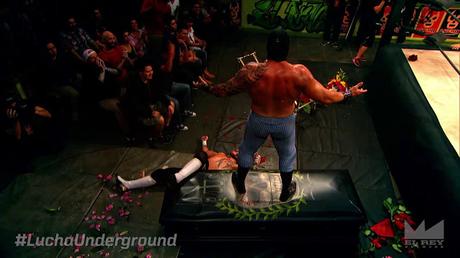
Less a wrestling match than a public showcase of attempted murder, this terrifying Lucha Underground showdown takes the limited concept of a casket match and makes it feel like life is truly on the line. Mil Muertes is a man possessed, busting open Fenix’s head after unscrewing a bottom rope (you can do that?) and belting him with the metal clip, then going right ahead and biting at the man’s open wound for extra effect. Throughout, both performers show an awareness of the psychology of a casket match that I haven’t even seen in the Taker casket matches I’ve watched. Neither man, least of all Muertes, goes for the casket for forever, because the point is not simply to trap your opponent for a win but to roll a proper corpse into their final resting place. The action spills everywhere, into a crowd that scatters to avoid the blood, onto a balcony for perilous near-throws, and all around a ring that gets more and more trashed. The best move happens surprisingly early, when Fenix gets a second wind and goes for a suicide dive through the ropes at Muertes, only for Muertes to whip the casket up to catch his opponent full in the face, leaving a sickening dent in the lid so deep it’s a miracle that Fenix’s head didn’t punch all the way through.
3. Hiroshi Tanahashi vs. Kazuchika Okada (Wrestle Kingdom 9)Singles Match for the IWGP Heavyweight Championship, January 4, 2015
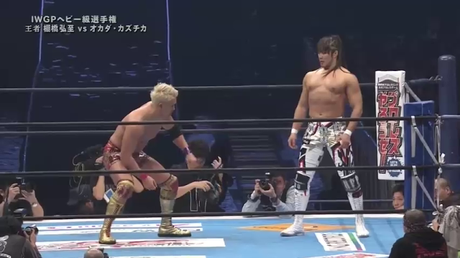
Wrestling in 2015 arguably peaked four days into the year at NJPW’s Wrestle Kingdom 9, an event with such a great card that even this masterpiece of a main event is not even the best match of the night. In fact, the first segment of this fight seems to be an extended cooldown of its showstopping predecessor, with both wrestlers exchanging holds and scouting each other to bring down the energy and to focus the crowd on what limbs are being targeted and what moves being set up. Both of the closing matches of the event set up a conflict between a dominant belt-holder and a long-struggling challenger who for various reasons, finally snaps and goes for the jugular. Okada sets things into motion properly by spoiling a clean break with a forearm before launching attacks that send the champion ringside, and from there he goes to town with a flurry of moves, including a hangman DDT on a guardrail that could make Randy Orton blush.
Okada’s energy is infectious, but unfortunately for him, Tanahashi catches it and begins to battle back with equal tenacity, including a signature out on the ramp. But more importantly, the champion, that goofy icon with the big hair and the air guitar, starts to show flashes of annoyance, then desperation as Okada repeatedly breaks through defenses and neutralizes Tanahashi’s assaults before he can get momentum. You can start to see the champion play a little dirty and hit a little harder to gain the upper hand. Then comes a downright insane move, where Tanahashi sends Okada over a guardrail, runs back into the ring and mounts the corner turnbuckle, and proceeds to hit a flying body press over the barricade and perfectly onto the challenger. In actuality the dive is probably “only” 20 feet or so, but when the camera throws out to a long shot of Okada crushed at the very edge of frame, behind the steel rail, as Tanahashi coils his legs, the distance between the two looks twice as long. And when Tanahashi hits the move flawlessly, you can feel the entire stadium rock with unleashed awe.
The match is so epic that even Okada’s Rainmaker finisher, a move so protected that no one has kicked out after receiving it, is not enough to keep Tanahashi down and stop the fight. (The only criticism you can levy at this match is that the wrestlers get back into things just a few seconds too soon after this momentous moment, but the crowd’s shock makes up for this miniscule miscalculation.) Tanahashi ingeniously manages to make this kick-out itself a vaguely meta heel turn, as if he legitimately refused to stay down and play ball just so he could teach this upstart a few more lessons. The post-match ridiculousness, with Tanahashi taking the mic to berate a crying Okada, is obvious set up for the aging Tanahashi to start fully passing the torch to Okada, maybe even at the Tokyo Dome show next week, but who wins this match, or the upcoming one, is irrelevant in the face of such entertainment.
2. Shinsuke Nakamura vs. Kota Ibushi (Wrestle Kingdom 9)Singles Match for the IWGP Intercontinental Championship
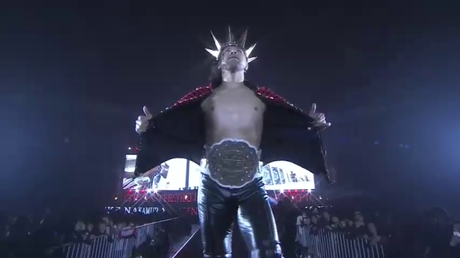
No other contemporary wrestler I watched this year entertained me as much as Shinsuke Nakamura. Daniel Bryan was an early favorite as I hustled through his arc against the Authority as well has the general quality of his wrestling in both WWE and his early ROH/Dragon Gate days, but a combination of terrible booking and potentially career-ending injury made his 2015 an unmitigated disaster and took some of the fun out of marking for him. But even if Bryan had a great year, it’s hard to imagine I still wouldn’t put Nakamura at the top. He is maybe my ideal wrestler, he cuts every bit the iconic profile of a heavy-hitter, with that leather get-up, his tendency to dance along to his own entrance music, and that to-the-rafters facial acting that sells everything from brash charisma to howling pain at the perfect balance between just enough and too much.
The Wrestle Kingdom Intercontinental match is the perfect showcase for Nakamura; even more than the Tanahashi bout later in the year, it allows him to deftly mix his “strong style” martial arts knowledge with his ring awareness. The G1 Final with Tanahashi is a meeting of two powerhouses, each scoping out the other, testing for weaknesses, then plowing ahead with everything. But Nakamura responds equally as well to Ibushi’s agility and high-flying antics, working to slow the pace to prevent his momentum from getting out of hand but also busting fast and furious attacks of his own, as in a stretch early on where he hits different knee attacks in the corner, on the apron and at ringside in a matter of seconds. It becomes downright hard to watch at times toward the end, when both men look like they’ve just thrown technique out the window in favor of beating the holy hell of the other guy.
Aiding the verve and passion of the wrestling is the focus of the story on display, of Nakamura, ever the bridesmaid for Tanahashi, belligerently holding onto the Intercontinental title as both proof of his worthiness and his chance to go after the top title. Ibushi, meanwhile, is the mid-carder who sees his chance to rise up by defeating the #2 guy, and a 2014 sidelined by injuries has made this a make-or-break match to get his name back into the conversation. Watching him steal Nakamura’s moves and mimic his expressions bypasses language barrier, and the elaborate move-set he employs is used with ferocious abandon. (Just watch him hit a brutal double stomp on Nakamura to send him out onto the apron, at which point Ibushi executes a dragon suplex from the second rope to hurl him back into the ring.) Ibushi was one of a horrifyingly long list of wrestlers who suffered major injuries in 2015, so this may be his last hurrah. But he damn sure left this match a star; Nakamura proves in this fight that he can do anything, but Ibushi proves he’s the man who will make him do absolutely everything to win.
1. Sasha Banks vs. Bayley (NXT Takeover: Brooklyn)Singles Match for the NXT Women’s Championship, August, 22, 2015
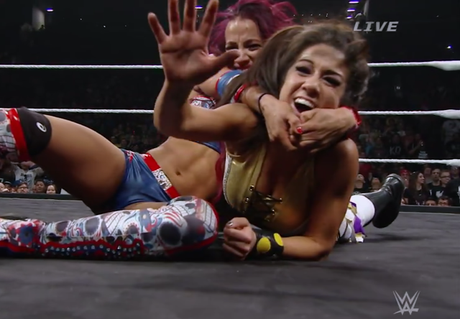
When I watched the Wrestlemania 13 main event between Bret Hart and Stone Cold Steve Austin, I felt like I was getting an education into the potential of great wrestling. Every single aspect of the match is perfect. Both performers are at the top of their game, and their minimal pre-show planning is actually a boon, as every single move has the feel of being fresh because most of it is improvised. Hart gets the win, but it’s Austin who emerges the victor, bravely refusing to tap out to the Hitman’s Sharpshooter hold while bleeding profusely from the forehead, passing out rather than give up. The commentary from Jim Ross and Jerry Lawler hones in on the details of each move to explain the complexity of the back-and-forth, but more importantly it subtly builds a narrative that shifts sympathy and reverence away from longtime babyface champion Hart onto the brash, antiheroic rising star Austin. Every single piece fits perfectly, to the point that it is not only a five-star classic piece of work but the mark of a major shift in WWE creative, away from its struggling transitional era into its Attitude phase.
That match came to mind watching Bayley face off against reigning NXT Women’s Champion Sasha Banks, not only because of, barring a few early botches, the quality of the wrestling but because it felt like a sea change for a company that has a horrid track record with women. This match isn’t nearly as technically proficient as the two Wrestle Kingdom showcases just before it on this list; the early stretch features one too many botches, however minor. But no other story in 2015 wrestling was as vital. The in-ring personality clash was a testament to how simplicity and clarity can be infinitely more sophisticated than needless complication; the Divas roster is constantly being reshuffled in heel turns that come and go on a weekly basis, but there is focus and consistency in keeping Bayley as a plucky, kind-hearted underdog and Banks as a vicious heel whose aggression masks a vulnerability that powers her most desperate and arrogant outbursts.
NXT’s commentary isn’t exactly amazing, but I’ll gladly take its directness and consistency to whatever the hell Raw’s haphazard use of JBL, Michael Cole and Jerry Lawler is. The announcers call clear attention to Bayley’s freshly healed broken wrist, a concise setup for the grisly, uncomfortable focus Banks puts on Bayley’s hand, as if she wants nothing more than to break it again. Divas matches, even to this newbie, fall into an easy patterns that set up submissions or roll-ups to end things after a few minutes. But Bayley and Sasha go to war, and even Bayley, who maintains her face image throughout, looks like she might truly put Sasha Banks into an early retirement. Bayley’s dropkick through the corner, Sasha’s brutal Bank Statement hold that Bayley miraculously reverses, and that top-rope inverted hurricanrana that brings things to a close are great moves on their face but are even more powerful as shows of intense effort. When Sasha cries at the end as Bayley stands victorious, it isn’t because she lost, it’s because she understands that she’s been a part of something truly major, and even if she and three-quarters of the Four Horsewomen have been utterly wasted on Raw since, it’s clear from this match that WWE can no longer afford to dismiss its women as eye-candy filler. Of course, WWE will almost certainly do so anyway, but if only for a night, these competitors made women’s wrestling the greatest thing in the entire world.

